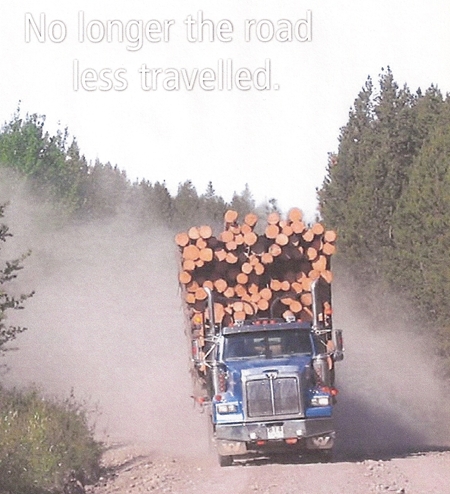Ombudsman Issues Report on Resource Roads
By 250 News

Forest Safety Ombudsman, Roger Harris has issued 17 recommendtions in his report on resource roads" No Longer the Road Less Travelled."
He calls for significant changes to enhance safety and protect the lives of the workers and public who use the roads and says addressing the issues is a shared responsibilityh requiring cross government, and cross industry support and participation.
Harris says the increase in use and the lack of clarity over who is responsible for the 400,000 kilometres of resource roads in the province has led to considerable safety challenges and issues requiring attention.
Harris says logging truck drivers are not the only ones who should be cautious on the resource roads, "I think one of the best quotes I heard came from a logging truck driver in Nelson who said the scariest vehicles I meet on the roads are all the light pick-ups and service trucks. They’re being driven like they were just stolen.”
A third recommendation calls for truck drivers to be certified and that certification extend to people who drive light-vehicles, such as pick-up trucks, ATV’s and four wheel drive vehicles.
1. The Province should establish a new public highway designation for resource roads that serve as the primary or secondary access roads for communities. The new designation would have clearly defined standards for construction, maintenance, enforcement and be funded/resourced similarly to the public highway system.
2. The Province should give strong consideration to extending the BC highways system model for compliance and enforcement of commercial vehicle regulations and inspections to this new road designation.
3. The Ministry of Forests and Range should take the lead in identifying which road systems this new road designation will apply to.
4. When a road system receives a “new road designation,” the standards for construction and maintenance on this road should be at the highest level needed by any industrial activity for which it will be regularly used.
5. The Province, through the Ministry of Forests and Range, should establish regional Road Safety Management Groups (RSMG) with the responsibility to manage all activities on resource roads in the province.
6. The Ministry of Forests and Range should identify the regional resource road networks that would logically be contained within any specific RSMG unit. The benefits of having an RSMG include:
- • Ensuring consistent and ongoing resource road maintenance• Ensuring a safer environment and reducing risk for road permit holders and road users
7. The Provincial Government should work with industry to ensure that capital costs of resource road construction and maintenance within an RSMG unit are fully recognized for the purpose of tax credits and stumpage calculations.
8. RSMGs should take an active role in supporting and assisting Industry Canada, BC Timber Sales, ICBC and the Ministry of Forests and Range to implement provincewide common signage, radio frequencies and radio protocols.
9. Until there is a formal network of RSMGs across the province, regulatory agencies working with industry should develop clear communication plans for local first responders. 10. All RSMGs should be required to put in place an Emergency Response Plan with protocols and procedures to facilitate the quickest response to any accident on resource roads in their management area. 11. The Ministry of Forests and Range and forest licence holders should undertake a collaborative review and overhaul of the stumpage appraisal system to identify and address impediments to timely decision making at the operational level. 12. The BC Forest Safety Council should develop an Industrial Drivers Endorsement Program for operators of light/service industrial vehicles operating on resource roads.
13. Responsibility for enforcing safety standards on resource roads should remain with government agencies currently charged with that responsibility--Ministry of Forests and Range, Ministry of Transportation, RCMP and WorkSafeBC--regardless of any changes in jurisdiction for resource road maintenance or operation.
14. The Province should undertake a full review of the inter-agency training for all Government Agencies responsible for enforcing provincial statutes to ensure that agencies responsible for enforcement of provincial statutes are applying those laws and regulations equally and with the same interpretation.
15. As part of its Section 26 Review, WorkSafeBC should incorporate individual cycle time reporting as a component of required documentation for log haul truck drivers.
16. The BC Forest Safety Council should include in the SAFE Companies Certification a requirement that companies identify and demonstrate a management process to track operational decisions from a safety perspective.
17. The Province should take the lead in advocating for Electronic Stability Control systems for all new industrial, commercial and private vehicles.
Harris says that while there may be numerous recommendations, in the end, it all boils down to one thing "It's how you and I react behind the wheel, people need to be responsible."
You can read the full report by clicking here.
Previous Story - Next Story
Return to Home










To me its simple. Ensure the infrastructure is up to standard as in road grade and shoulder width and tie road incident rates to the ability of the forest company to use road expenses for tax write off purposes.
I in particular do not like the following recommendation:
"12. The BC Forest Safety Council should develop an Industrial Drivers Endorsement Program for operators of light/service industrial vehicles operating on resource roads."
This just seems like another attempt by government to ban the public from the public forests so that they can then later privatize everything and the people will not then know what is being removed from public access. Either that or/and it is a further attempt to regulate who works in the forest industry through the creation of needless certifications that restrict employment oportunties to those with the inside track.